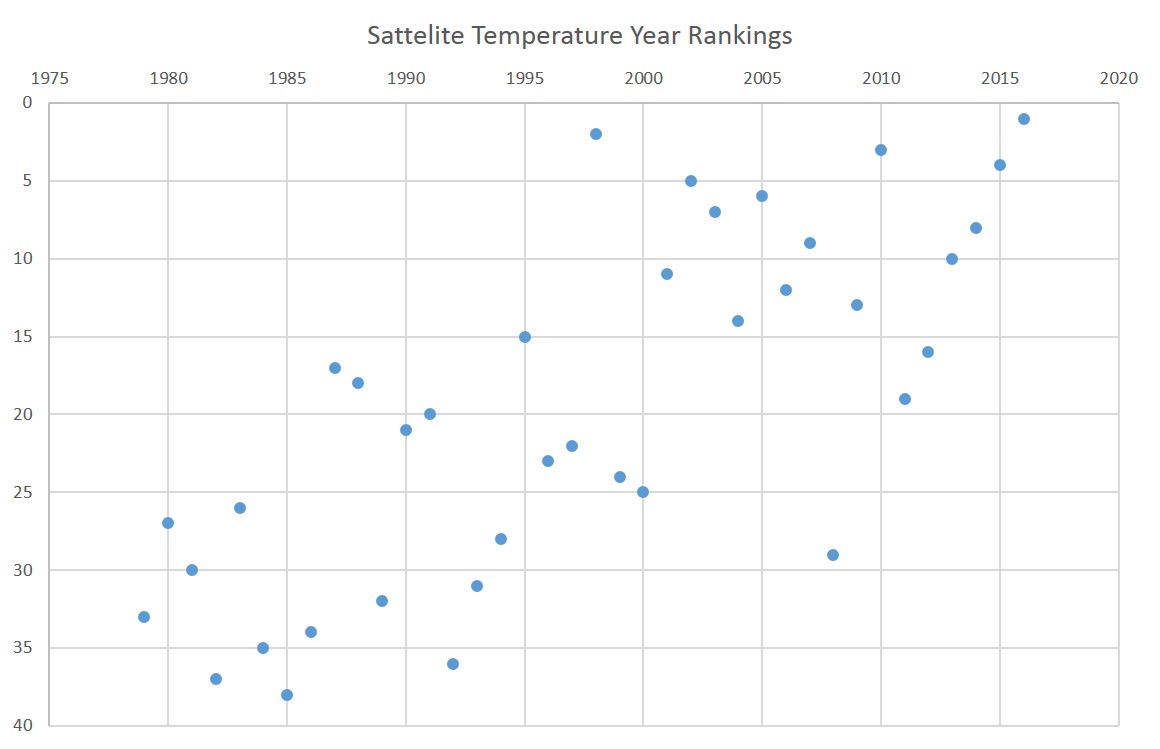The prefered temperature record of the warming-doubters has released the monthly update for December http://www.drroyspencer.com/2017/01/global-satellites-2016-not-statistically-warmer-than-1998/
Roy Spencer puts a brave face on the headline by pointing out that 2016 wasn’t statistically hotter than the second warmest year in the satellite temperature record. Yet that is cold (warm?) comfort to those who hope that natural causes are behind global warming. The December 2016 anomaly is a drop after the El Nino of 2016 had passed but even so is relatively high.
In July Spencer had been more sceptical (not unreasonably) that 2016 would match 1998 but temperatures cooled less than was expected through the rest of the year.
Here is a different way of looking at these record years. This isn’t a great way of showing the data because one axis is just ordinal but I think it provides a change from the usual graphs.

Each year of the UAH sattelite record is plotted against its rank (1 = warmest). I’ve listed 1998 as rank 2, which might be visually misleading as the difference between 2016 and 1998 is not significant. What the graph shows is the chance of a record year increases with some reliability as we move forward in time.
Yes, to some extent it is neither here nor there whether a given year is a record or not. The actual issue is the steady warming across the board.



15 responses to “So how did December 2016 go in the satellite temperatures?”
http://dailycaller.com/2017/01/02/greenland-enters-2017-adding-extraordinary-amounts-of-ice-and-snow/#ixzz4UlDcV78e
Odd, during the hottest year on record.
LikeLike
Are you saying that 2016 was NOT the hottest year on record?
LikeLike
You have a penchant for putting words in people’s mouths, Camestros.
I’m saying it is odd that Greenland is adding that much ice mass during the hottest year on record.
Also odd that it is snowing in Istanbul.
Also odd that the USA is breaking temperature records on the downside.
Because “hottest year on record.”
However I will add that I have no confidence in -any- of the climate science these days, because the field has become hopelessly compromised by politics. If a “climate scientist” said it was cold in Canada today, I would look out the window to check the thermometer myself. It might very well be the hottest year on record, but it might also be shenanigans.
And before you leap to object that “weather is not climate,” I know that. As we have all seen countless times the last 20 odd years, weather is only climate when it it hot. Never when it is cold. Only high temp records matter, never low ones. Only hurricanes count, never snow storms.
That’s why the thinking man in these degenerate times is a skeptic, not a follower of the mass media.
LikeLike
So you are just flapping your hands in the breeze it seems. Oh well. You know where I am when you’ve got your thoughts together.
LikeLike
Here’s some more hand flapping while you wait: https://youtu.be/g5LpwL4NKbw
LikeLike
Not sure how that makes 2016 any cooler Phantom.
LikeLike
Scientific fraud is an insidious thing, Camestros. Fruit of the poisoned tree, you know.
-Is- this the hottest year on record? Or is it more that previous decades have been adjusted downward? Inquiring minds want to know, and we can’t find out because fruit of the poisoned tree.
An inconvenient truth.
LikeLike
// Or is it more that previous decades have been adjusted downward?//
You say some really stupid things Phantom.
The figures I showed you are from the sattelite temperature record curated by a notable climate “skeptic” Dr Roy Spencer. You are just to ignorant to even realise that you just defame somebody who is actually on YOUR side of the argument.
So yes, 2016 really, really is the hottest year on record. Throwing baseless accusations of fraud because reality disagrees with your politics is an insidious thing Phantom. It’s what’s poisoning conservative from the roots upwards and undermining democracy because one half of the political equation has lost its moral compass completely.
LikeLike
Warmer polar waters means more evaporation and hence more snow. The lake-effect snow they get around the Great Lakes in the winter is a good example of how that works. The lakes stay relatively warm and liquid after the air has gotten cold and dry, so the air sucks up enormous amounts of water vapor when it passes over the lakes and then promptly dumps it on the land.
Similarly, if you warm up the ocean around Greenland a little bit, you should expect an increase in the snowfall.
LikeLike
>Also odd that it is snowing in Istanbul.
Not really. It snows here every winter and there are ski resorts 60 miles away.
LikeLike
“It snows here every winter…”
Yeah? Who makes your snow plows?
LikeLike
Istanbul municipality uses MAN snow plows. It’s a German company, but they have production facilities in Turkey as well.
Do you think I’m making this up or something?
LikeLike
Yes, he probably does think you are making it up and/or that the Turkish government manufacture snow in an attempt to make him look wrong.
LikeLike
Its more that the roofs of buildings in Istanbul don’t seem designed to bear a large snow load. Shallow peaks. Istanbul is not known for snow, generally. But, if I’m wrong, I’m wrong.
New York City uses garbage trucks with a crappy plow blade on the front. Type of thing normally seen on landscaper’s pickup trucks for plowing suburban driveways. Twelve inches will shut the place down for a day or two.
I’ve seen snow in Scottsdale Arizona. School was cancelled so the kids could go play in it.
Where I live, school gets cancelled when the school bus is buried. It happens occasionally. Six inches is considered a “light dusting.”
This is what we have in Ontario: https://www.google.ca/search?q=man+snow+plow&biw=1920&bih=843&tbm=isch&tbo=u&source=univ&sa=X&ved=0ahUKEwi1nIDpl7bRAhVK2IMKHQx5A4AQsAQIGQ#tbm=isch&q=ontario+snow+plow&imgrc=hC0YZ5HX_O7wcM%3A
LikeLike
Well, it is true that Istanbul is not Canada and we don’t have long snowy winters. But it’s certainly not unusual for it to snow here.
LikeLike